
I have memories of gyoza from when I was in kindergarten. My grandma would invite my mom and aunts to her house -- and they would wrap dumplings all day. My cousins and I would run around, play in the pool and take Oreo and orange juice breaks throughout the day. When the sun began to set, the smell of fried gyoza would begin to fill the house and we would all be rewarded for our grandma's and mothers' hard work.
These memories are both a blessing and curse for my relationship with gyoza. I always want to eat them to remind me of those idyllic days, but I am daunted by task of making them.
When I do decide to make gyoza, I am usually by myself, so I have to reserve at least half a day for gyoza-making. But unlike, my grandma's massive yield, I only end up making about 50. It's a time-consuming task that you have little to show for in the end. But it's also a great activity when I feel like I need a time-out from computers and cell phones.
I have experimented with a lot of gyoza fillings, but I swear by a pork and chicken mixture. I am also a huge fan of the
allium family (onions, garlic, etc.) so I will put many types of allium bulbs into my gyoza. This adds an extra fresh crunch against the pork-chicken backdrop.
I've also tried lots of gyoza skins. Your local market may have several types and you will have to try out different types to come upon the one you like best. I am typically a fan of thinner skinned gyoza, so I look for skins at the Japanese market. The skins at Chinese markets tend to be a little thicker.
I found some fresh (unfrozen), delicious skins at the Berkeley Bowl that are more yellow than I'm used to but very thin. I took a chance on these, given there is no brand name on it, but I was very satisfied with the results. It has a great shiny look to it when cooked and I think there is extra egg in the dough, which probably gives it its bright yellow color and a satisfyingly mild, savory taste.
INGREDIENTS
1 lb ground pork
1 lb ground chicken
2 eggs
100 gyoza skins
1/2 green cabbage
1/2 onion
1 shallot
1 bunch of chives
4 cloves garlic
2 tsp grated ginger
4 tbsp soy sauce
4 tbsp sesame oil
6-10 drops of La-yu chili oil
Potato starch for sprinkling
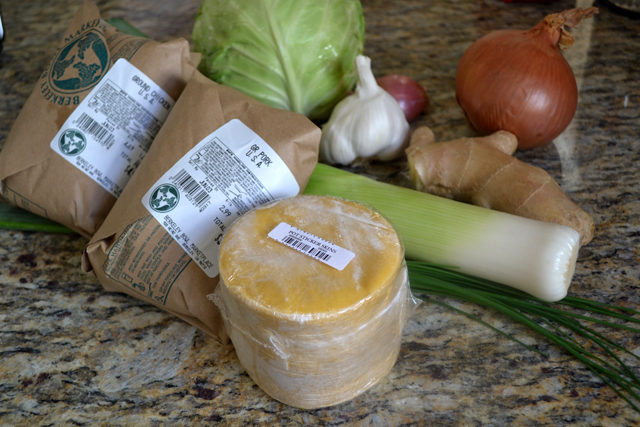 METHOD
METHOD
1. The key to successful gyoza filling and finely chopped ingredients. They should be as fine as you can chop them (without going crazy).
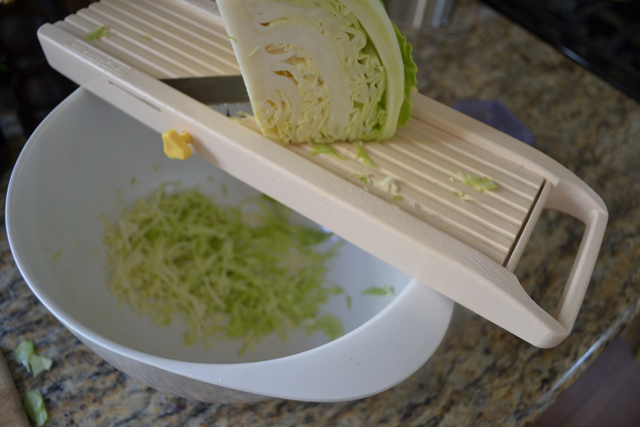
2. Chop the following finely: cabbage, onion, shallot and chives. Put ingredients in large mixing bowl.

3. Grate the following: garlic and ginger and add to the bowl.

4. Add the ground meats and egg to the bowl.

5. Add the soy sauce, sesame oil and la-yu chili oil to bowl.

6. Mix the ingredients really well with your hands.

Don't be afraid to get your hands IN there.

7. Wash hands and prepare cookie sheets or shallow plastic containers for wrapped gyoza. Sprinkle the sheet or containers liberally with potato starch*.

*
Mom tip: use katakuriko
(potato starch) instead of regular flour so the gyoza won't stick together.
8. Prepare a water bowl to wet your fingers with to help "glue" the skin together.

9. Place a gyoza wrapper on the palm of your hand. A little less than a tablespoon will fit into each skin. Place the filling in the middle of the skin. Don't overstuff it, or you'll be dealing with a lot of broken, soggy gyoza skins.

10. Wet the edge of half the gyoza skin with your finger (see above how the top edges of the skin is wet).
11. Fold over the dry side onto the wet side of the skin and gently pleat. You don't need to go overboard with the pleating. 3-4 pleats are plenty.
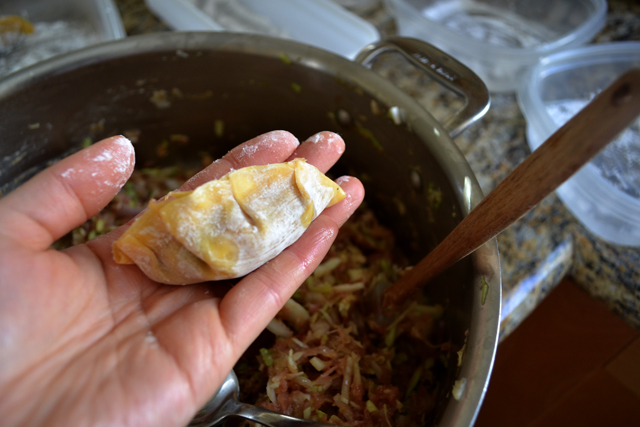
12. Place in a row onto your holding container or cookie sheet.
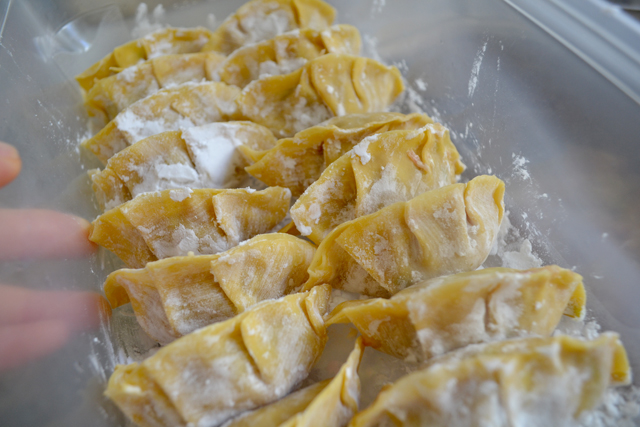
13. Once you've filled a container sprinkle more potato starch on top, fit the lid or wrap tightly with plastic wrap and place in freezer. If you want to eat them right away, place them in the fridge, until you are done with wrapping all the gyoza.
After wrapping about 30 gyoza, I got really impatient and switched to the shumai format (way easier to make than gyoza).
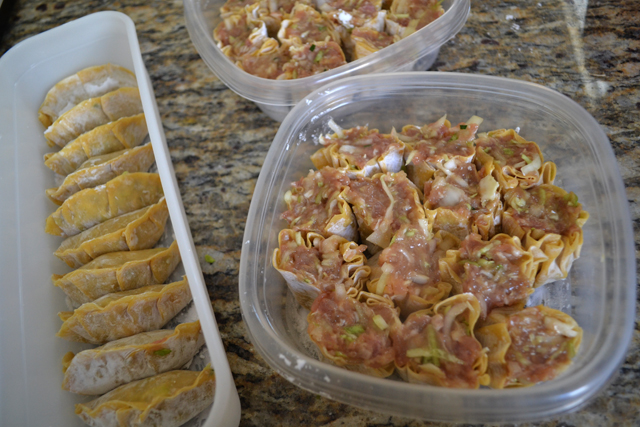
Even then, I ended up wrapping up about a third of the filling in saran wrap and freezing it because I got too tired of wrapping. My grandma had it right. Next time, I'll invite a bunch of people over and have a gyoza-wrapping party. Anyone game?
Next week: Frying gyoza.
 I have memories of gyoza from when I was in kindergarten. My grandma would invite my mom and aunts to her house -- and they would wrap dumplings all day. My cousins and I would run around, play in the pool and take Oreo and orange juice breaks throughout the day. When the sun began to set, the smell of fried gyoza would begin to fill the house and we would all be rewarded for our grandma's and mothers' hard work.
These memories are both a blessing and curse for my relationship with gyoza. I always want to eat them to remind me of those idyllic days, but I am daunted by task of making them.
When I do decide to make gyoza, I am usually by myself, so I have to reserve at least half a day for gyoza-making. But unlike, my grandma's massive yield, I only end up making about 50. It's a time-consuming task that you have little to show for in the end. But it's also a great activity when I feel like I need a time-out from computers and cell phones.
I have experimented with a lot of gyoza fillings, but I swear by a pork and chicken mixture. I am also a huge fan of the allium family (onions, garlic, etc.) so I will put many types of allium bulbs into my gyoza. This adds an extra fresh crunch against the pork-chicken backdrop.
I've also tried lots of gyoza skins. Your local market may have several types and you will have to try out different types to come upon the one you like best. I am typically a fan of thinner skinned gyoza, so I look for skins at the Japanese market. The skins at Chinese markets tend to be a little thicker.
I found some fresh (unfrozen), delicious skins at the Berkeley Bowl that are more yellow than I'm used to but very thin. I took a chance on these, given there is no brand name on it, but I was very satisfied with the results. It has a great shiny look to it when cooked and I think there is extra egg in the dough, which probably gives it its bright yellow color and a satisfyingly mild, savory taste.
INGREDIENTS
1 lb ground pork
1 lb ground chicken
2 eggs
100 gyoza skins
1/2 green cabbage
1/2 onion
1 shallot
1 bunch of chives
4 cloves garlic
2 tsp grated ginger
4 tbsp soy sauce
4 tbsp sesame oil
6-10 drops of La-yu chili oil
Potato starch for sprinkling
I have memories of gyoza from when I was in kindergarten. My grandma would invite my mom and aunts to her house -- and they would wrap dumplings all day. My cousins and I would run around, play in the pool and take Oreo and orange juice breaks throughout the day. When the sun began to set, the smell of fried gyoza would begin to fill the house and we would all be rewarded for our grandma's and mothers' hard work.
These memories are both a blessing and curse for my relationship with gyoza. I always want to eat them to remind me of those idyllic days, but I am daunted by task of making them.
When I do decide to make gyoza, I am usually by myself, so I have to reserve at least half a day for gyoza-making. But unlike, my grandma's massive yield, I only end up making about 50. It's a time-consuming task that you have little to show for in the end. But it's also a great activity when I feel like I need a time-out from computers and cell phones.
I have experimented with a lot of gyoza fillings, but I swear by a pork and chicken mixture. I am also a huge fan of the allium family (onions, garlic, etc.) so I will put many types of allium bulbs into my gyoza. This adds an extra fresh crunch against the pork-chicken backdrop.
I've also tried lots of gyoza skins. Your local market may have several types and you will have to try out different types to come upon the one you like best. I am typically a fan of thinner skinned gyoza, so I look for skins at the Japanese market. The skins at Chinese markets tend to be a little thicker.
I found some fresh (unfrozen), delicious skins at the Berkeley Bowl that are more yellow than I'm used to but very thin. I took a chance on these, given there is no brand name on it, but I was very satisfied with the results. It has a great shiny look to it when cooked and I think there is extra egg in the dough, which probably gives it its bright yellow color and a satisfyingly mild, savory taste.
INGREDIENTS
1 lb ground pork
1 lb ground chicken
2 eggs
100 gyoza skins
1/2 green cabbage
1/2 onion
1 shallot
1 bunch of chives
4 cloves garlic
2 tsp grated ginger
4 tbsp soy sauce
4 tbsp sesame oil
6-10 drops of La-yu chili oil
Potato starch for sprinkling
 METHOD
1. The key to successful gyoza filling and finely chopped ingredients. They should be as fine as you can chop them (without going crazy).
METHOD
1. The key to successful gyoza filling and finely chopped ingredients. They should be as fine as you can chop them (without going crazy).
 2. Chop the following finely: cabbage, onion, shallot and chives. Put ingredients in large mixing bowl.
2. Chop the following finely: cabbage, onion, shallot and chives. Put ingredients in large mixing bowl.
 3. Grate the following: garlic and ginger and add to the bowl.
3. Grate the following: garlic and ginger and add to the bowl.
 4. Add the ground meats and egg to the bowl.
4. Add the ground meats and egg to the bowl.
 5. Add the soy sauce, sesame oil and la-yu chili oil to bowl.
5. Add the soy sauce, sesame oil and la-yu chili oil to bowl.
 6. Mix the ingredients really well with your hands.
6. Mix the ingredients really well with your hands.
 Don't be afraid to get your hands IN there.
Don't be afraid to get your hands IN there.
 7. Wash hands and prepare cookie sheets or shallow plastic containers for wrapped gyoza. Sprinkle the sheet or containers liberally with potato starch*.
7. Wash hands and prepare cookie sheets or shallow plastic containers for wrapped gyoza. Sprinkle the sheet or containers liberally with potato starch*.
 *Mom tip: use katakuriko (potato starch) instead of regular flour so the gyoza won't stick together.
8. Prepare a water bowl to wet your fingers with to help "glue" the skin together.
*Mom tip: use katakuriko (potato starch) instead of regular flour so the gyoza won't stick together.
8. Prepare a water bowl to wet your fingers with to help "glue" the skin together.
 9. Place a gyoza wrapper on the palm of your hand. A little less than a tablespoon will fit into each skin. Place the filling in the middle of the skin. Don't overstuff it, or you'll be dealing with a lot of broken, soggy gyoza skins.
9. Place a gyoza wrapper on the palm of your hand. A little less than a tablespoon will fit into each skin. Place the filling in the middle of the skin. Don't overstuff it, or you'll be dealing with a lot of broken, soggy gyoza skins.
 10. Wet the edge of half the gyoza skin with your finger (see above how the top edges of the skin is wet).
11. Fold over the dry side onto the wet side of the skin and gently pleat. You don't need to go overboard with the pleating. 3-4 pleats are plenty.
10. Wet the edge of half the gyoza skin with your finger (see above how the top edges of the skin is wet).
11. Fold over the dry side onto the wet side of the skin and gently pleat. You don't need to go overboard with the pleating. 3-4 pleats are plenty.
 12. Place in a row onto your holding container or cookie sheet.
12. Place in a row onto your holding container or cookie sheet.
 13. Once you've filled a container sprinkle more potato starch on top, fit the lid or wrap tightly with plastic wrap and place in freezer. If you want to eat them right away, place them in the fridge, until you are done with wrapping all the gyoza.
After wrapping about 30 gyoza, I got really impatient and switched to the shumai format (way easier to make than gyoza).
13. Once you've filled a container sprinkle more potato starch on top, fit the lid or wrap tightly with plastic wrap and place in freezer. If you want to eat them right away, place them in the fridge, until you are done with wrapping all the gyoza.
After wrapping about 30 gyoza, I got really impatient and switched to the shumai format (way easier to make than gyoza).
 Even then, I ended up wrapping up about a third of the filling in saran wrap and freezing it because I got too tired of wrapping. My grandma had it right. Next time, I'll invite a bunch of people over and have a gyoza-wrapping party. Anyone game?
Next week: Frying gyoza.
Even then, I ended up wrapping up about a third of the filling in saran wrap and freezing it because I got too tired of wrapping. My grandma had it right. Next time, I'll invite a bunch of people over and have a gyoza-wrapping party. Anyone game?
Next week: Frying gyoza.




Comments (12)
I totally feel your dread in the task of making gyoza. It ain’t lazy, that’s for sure. But I’m getting a Benriner asap so I don’t have to chop so much. I’m also going to try the pork/chicken ratio.
Sometimes, I want to be a kid again, eat Cheetos, play in the pool, and have dinner waiting for me when I’m done with the sun. What a life!
These were delicious. Looking forward to Part 2!
Count me in! We used to have family wonton making nights. The post brings back good memories of those nights.
Okay, great. Let’s do it soon. Gyoza Support Group 2013.
This looks amazing! I’m going to try it one of these days. although i’m scared it’s much harder than it looks in this post!
I’m glad to see you using chili oil, as it is one of the great Asian cooking secrets. However, the La-Yu brand has slipped in quality. If you examine the label in photo number seven, you will see that its second ingredient is corn oil. The only reason for this is economy and it dilutes the product.
When I first started using La-Yu back in the 1980s, the product only contained roasted sesame oil. Nearly all of the various Asian versions are now cut with soy or corn oil.
Amazing as it might seem, the relatively ubiquitous Dynasty brand (JFC International) of goma rayu has only two ingredients, sesame oil and chili. It is more economical at under $6.00 for 100 ml (3.5 fluid ounces) than, for instance, House Ra Yu (by the Japanese distributor, House Foods Corporation), which costs over $2.00 for 33 ml (1.1 fluid ounces). Both products have only the two ingredients. The smaller House Ra Yu bottles make it easier to smuggle into the restaurants but, me being such a cheapskate, I refill them from the larger container.
One of my favorite ways of using this delightful condiment is as part of a dipping sauce for dim sum. I grab some extra tea cups from the waiter’s station and mix it with soy sauce. Is it the equivalent of putting ketchup on French food? Well, yes, but it’s totally addictive. So there!
If you are doing this at home, be sure to add some julienne of ginger plus finely minced garlic and scallions.
When you really want to go whole hog, try mixing goma rayu with Kikkoman’s kappou sashimi shoyu. This product is the Cabernet Sauvignon of soy sauces. Do not be fooled by other “sashimi” soy sauces, not even those by Kikkoman. The kappou shoyu is laced with mirin (rice wine) plus bonito and kombu extract, its umami factor is off the chart. This I bring to the sushi bar, but that’s another story (it also doctors up miso soup or ramen quite nicely).
As for gyoza, be sure to add a little red (not red wine) Chinese vinegar to your dipping sauce. As with pot stickers, it adds a wonderful zesty note that is so satisfying.
Incidentally, in your recipe it appears as though you neglected to mention what it either a leek or large negi Japanese-style green onion.
Additionally, speaking as a fellow chive enthusiast, it seems as though you are using triangular-shaped garlic chives (Allium tuberosum), as opposed to the more common regular chive (Allium schoenoprasum). You are also very fortunate in having Berkeley Bowl to shop at. Their produce selection is excellent. Fortunately, I’ve got Mitsuwa Marketplace and Lion Super to fill the bill.
Hey Chris,
That is great to know about the La-yu. I will definitely check out the Dynasty brand next time. I love how you smuggle it into restaurants!! All of this sauce talk is making me want to run to Chinatown. I will also go out and buy some red Chinese vinegar.
For this recipe I was using a regular leek because they didn’t have good-looking Tokyo negi that day. But my preference would be to use 2-3 stalks of Tokyo negi instead of one leek. Thanks for pointing that out.
Yes, I am very fortunate to be shopping at the Berkeley Bowl. They never fail as far as produce selection. But at least you do have a Japanese market nearby. Are you in the South Bay?
This reminds me you must still show us how to fry them! I always find this to be the trickiest part.
yoko: I will also go out and buy some red Chinese vinegar.
I promise that you’re going to love the flavor of Chinese red vinegar with your gyoza dipping sauce. Unfortunately, in most cases the coloration results from an artificial dye such as Red #40 or, worse, Sudan Red G. If you have access to a serious Japanese supermarket, look to see if they carry an authentic red vinegar whose crimson hue is derived from the use of red yeast rice (Chinese: hóng qū mǐ or Japanese: akakoji).
That said, please do not miss the Kikkoman kappou sashimi shoyu. If you finally manage to get your mitts on a bottle of this Nipponese ambrosia, be sure to do a side-by-side taste test with any other preferred soy sauce. You will be amazed at the dramatic difference in flavor. It’s available from the Mitsuwa Net Shop at $4.49 for 200 ml (6.8 fluid oz.) and well worth ordering if it is unavailable in your area. Smuggle a bottle into your favorite sushi bar and be prepared for a quantum jump in fine dining.
A similarly exceptional Asian cooking product is Lee Kum Kee’s top grade oyster sauce. Designated as “”http://www.lovesfoodandart.com/wp-content/uploads/2012/05/Oyster-Sauce1.jpg" rel="nofollow">Premium Oyster Flavored Sauce", the ornately illustrated label stands out on the supermarket shelf just as it will in your wok. Again, any other commonly available oyster sauce simply won’t survive a side-by-side comparison with this delightfully complex and savory condiment.
Are you in the South Bay?
Yes, and although I’m not in the North Bay area too often, Umami Mart is now on my list of must-visit destinations when I next head that way. If anything, I’ll drop by your shop just because I’m half Danish and the way that your new konbini merges Anders Arhoj’s modern Scandinavian design with traditionally austere Japanese styling is a visual delight.
Thank you for posting my lengthy comments. I hope that your readers find them useful and informative.
@Chris: Thanks for all of this information. This gives me an idea, that maybe we should have a condiment tasting here at Umami Mart sometime!
We will look forward to your visit.